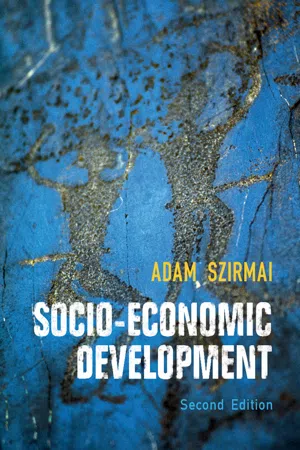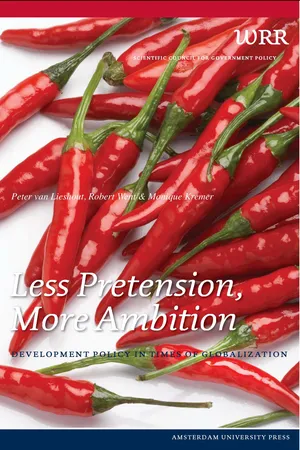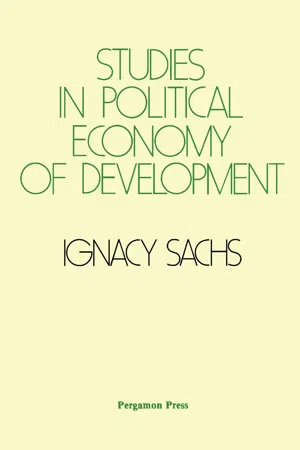Social Sciences
Aid
Aid refers to the assistance or support provided to individuals, communities, or countries in need, often in the form of resources, expertise, or funding. It can be aimed at addressing various social, economic, or humanitarian challenges, and is typically delivered by governments, non-governmental organizations, or international agencies. The goal of aid is to improve the well-being and development of the recipients.
Written by Perlego with AI-assistance
Related key terms
1 of 5
3 Key excerpts on "Aid"
- eBook - PDF
- Adam Szirmai(Author)
- 2015(Publication Date)
- Cambridge University Press(Publisher)
Aid is not a marginal phenomenon here. It represents one of the key facts of economic life. The debate on the quality and the effects of Aid is not just an academic debate. It touches on the economic prospects of the poorest African countries. 14.5 Theories of development and objectives of Aid ................................................................................. Discussions of foreign Aid are implicitly or explicitly based on theories of socio-economic development, in which Aid fl ows can ful fi l certain functions (Bauer, 1981 ; Bos, 1990 ; Bruton, 1969 ; Cassen, 1986 ; Dijkstra and White, 2003 ; Krueger et al. , 1989 ; Hermes and Lensink, 2001b ; Lensink, 1993a ; Riddell, 1987 , 2008). Together with normative considerations, these theories determine the speci fi c goals and objectives one hopes to realise by means of development Aid. Aid has a variety of objectives including: self-sustaining growth, poverty reduction, coping with humanitarian emergencies and disasters, environmental sustainability of economic development, improving the position of women and good governance and democratisation (Lensink and White, 2001 ; World Bank, 2002a ). In keeping with the main focus of this book we focus primarily on the fi rst two goals, though the other objectives will be discussed incidentally. 14.5.1 Aid as a source of investment, capital accumulation and growth The foundations of theories of the role of foreign Aid in development were lAid in the 1950s and 1960s. As sketched in the chapter on industrialisation strategies ( Chapter 9 ), the prevailing assumption was that developing countries were caught in vicious cycles of poverty. Due to low incomes per capita, savings were low. Due to low savings rates, investment was low, so that there were little prospects for future growth of national income and development of the industrial sector. 626 Socio-Economic Development Capital was seen as the scarce factor in development. - No longer available |Learn more
Less Pretension, More Ambition
Development Policy in Times of Globalization
- Peter van Lieshout, Robert Went, Monique Kremer(Authors)
- 2010(Publication Date)
- Amsterdam University Press(Publisher)
7 being more specific: professionalizing Aid What is required to make a serious contribution to development? As we have seen, there is no Big Answer to that question. Societies cannot be ‘fixed’. Develop-ment Aid should aim to increase self-sufficiency, and be tailored to the specific situation and problems in the country concerned. Anyone who takes this as a seri-ous starting point will not act on the basis of yet another grand, universal theory of development, but on a heterogeneous, better substantiated and targeted collection of local policy practices. 7.1 appropriate Aid modalities Asking how to shape development is to ask not only what, but also how. The debate on ‘what’ is many times more intensive than the question of ‘how’. Aid presupposes a thorough reflection on which instruments to deploy, but that is a surprisingly neglected issue. There has been little systematic reflection on how Aid can best be provided. To be more precise, there is a whole body of literature on specific intervention variants – for example, the various forms of microcredit have been evaluated extensively – but the question of how this Aid relates to the ‘politi-cal economy’ of a country is almost invariably ignored. At micro level there is a wide range of insights into the exact design of Aid projects, but the issue of whether Aid can better be provided through ngo s or local government is much less systematically examined. Choice of instruments is often a matter of prefer-ence, with some people believing that governments are the best channel, and others placing their trust in multilateral organizations, ngo s or the private sector. This neglect is partly based on the implicit assumption that all Aid is worthwhile. As long as it is aimed at reducing poverty, every person who is alleviated from poverty is a positive result, no matter who provides the Aid. - eBook - PDF
- Ignacy Sachs(Author)
- 2013(Publication Date)
- Pergamon(Publisher)
CHAPTER 6 Forms ofForeign Aid — An Economic Analysis (1966)* Introduction Few topics are the object of a more voluminous literature than foreign Aid. And yet the very concept of foreign Aid needs clarification. 1 This will be the main purpose of this chapter, which, at the same time, will review the principal forms of economic Aid and evaluate them. The chapter is in three parts. The second reviews the different modali-ties of economic Aid. The third discusses the problem of Aid through trade. Use has been made of contributions and reviews of literature prepared by the following authors, to whom go our thanks: I. Blaszczyszyn, J. Kotowicz, T. Kozak, M. Paszynski, C. Prawdzic, and W. Rydygier. Foreign Aid and economic development DEFINITION OF ECONOMIC Aid From the point of view of the recipient country foreign economic Aid occurs when: (a) The country receives additional resources in foreign currency (or its equivalent in goods) over the capacity to import generated by exports or financed from accumulated reserves, without the need of * Paper written with Michal Kalecki. 1 To quote the so-called Jeanneney report, L'Aide est une notion ambiguee et sa mesure chiffree malaisee (La Politique de Cooperation avec les Pays en Vote de Developpment, Paris, 1963, p. 51). 130 immediate repayment and at a cost lower than the prevailing rates of commercial loans. (b) These additional resources are used in order to improve the recip-ient country's economic performance above the level otherwise attain-able, i.e. either the country achieves a higher rate of growth without reducing the anticipated consumption of working people or it imple-ments the anticipated rate of growth, managing to increase the volume of popular consumption over the anticipated «level.
Index pages curate the most relevant extracts from our library of academic textbooks. They’ve been created using an in-house natural language model (NLM), each adding context and meaning to key research topics.


